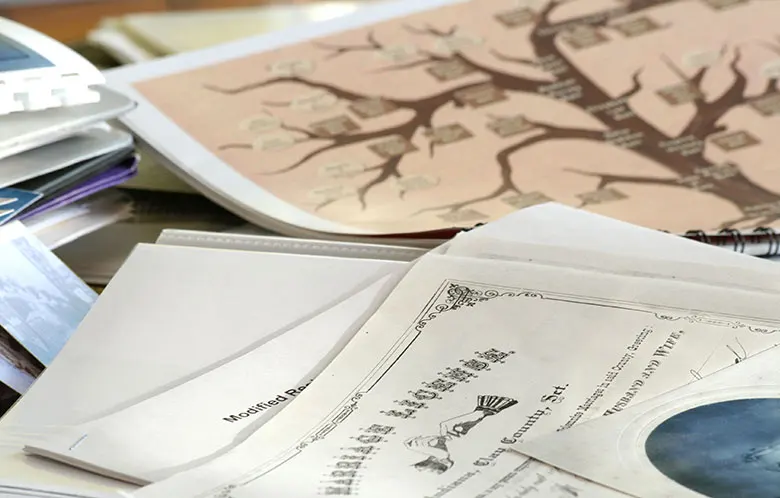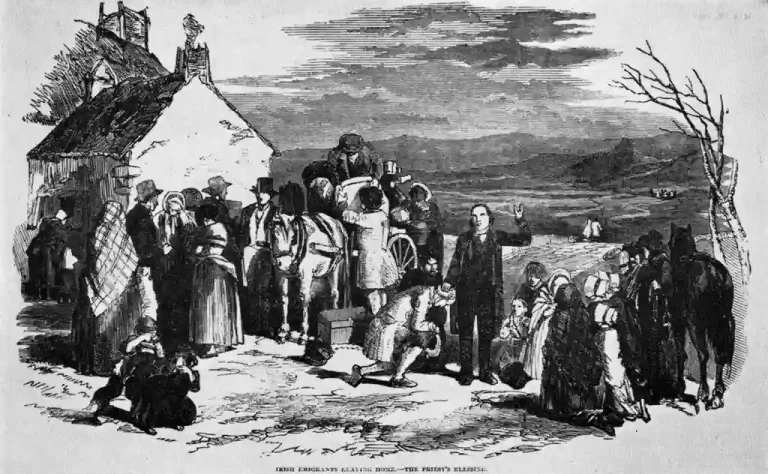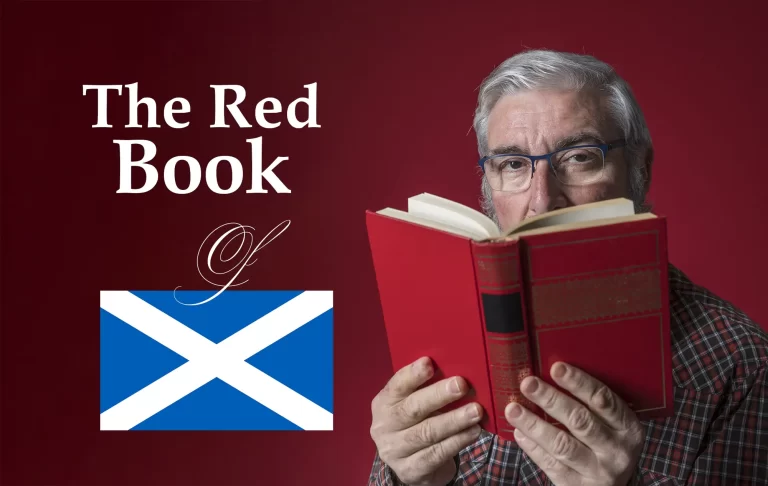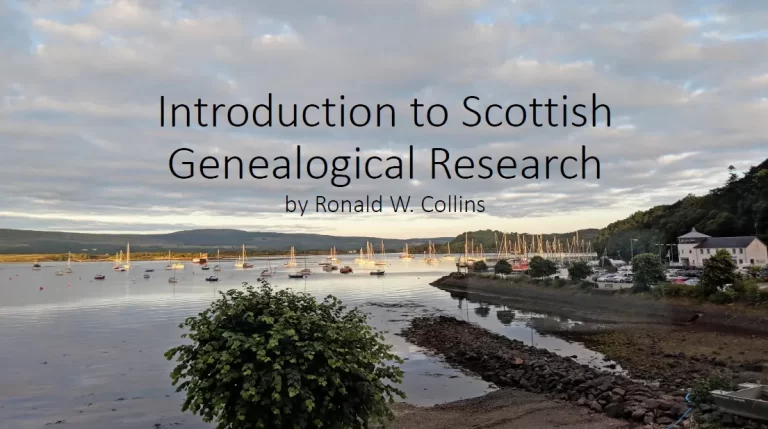The Basics of Scottish Genealogical Research

Civil registration of births, marriages and deaths in Scotland was introduced in 1855. As you can imagine, birth records are extremely helpful in tracing Scottish ancestry. They provide the child’s name, sex and date and place of birth, they also sometimes include the date and location of their parents’ marriage.
In Scotland parental consent was never required for minors (people under 21) to marry. Civil marriage, performed by a registrar as the celebrant, started in Scotland in 1940. Scotland legally provided for “irregular marriages’” up to that time by ‘declaration’, where two spouses declared their intent to marry before witnesses, without a celebrant. In such a case you will see the words ‘by warrant of the sheriff substitute’ in the left-hand column of the record, as state permission was required to register such an event. The records will also note details about the couple’s fathers and mothers.
Besides Birth and Marriage records, you will want to explore Death Records. Death certificates name all known former spouses, where and when death occurred, as well as the cause, and usually the names of both parents. Be careful, these records were filled in after the person died, and many times the informant may not have the correct information.
Before 1855, the only records of milestone events were these four: baptism, marriage banns, marriage ceremonial and death/burial records from the registers of their local church. The Scottish church played an important part in the lives of its parishioners beyond just marking births, marriages and deaths. Church sessions were held to keep the congregation in check, policing moral and local matters.
Scotland has full census records available from 1841 to 1911. Census questions included whether inhabitants spoke Gaelic in 1881 and there were also questions about rooms with windows and whether children were being educated at school, etc.. Note that in Scotland women kept their maiden surname after marriage – as such, when widowed, you may find a woman reverting to her maiden name, rather than continue with her married surname.
Wills are another great source of information. In Scotland, there were two types of property left behind after death – moveable and heritable. Moveable estate comprised assets that were essentially not land or buildings. Up to the early 19th century certain relatives were automatically entitled to part of this estate, after it was divided into three – the ‘widow’s part’, the ‘bairns’ part’ (i.e. the children of the deceased), and the ‘deid’s part’ (i.e. everyone else including debtors to whom the deceased wished to leave something). A will would express how the deceased wanted the ‘deid’s part’ to be bequeathed through the ‘confirmation’ process (what we call ‘probate’). The eldest son was usually entitled to inherit the heritable estate, ie, land and property (according to the law of primogeniture.
So, where do you find sources for all these types of data?
A discussion of Sources
Without a doubt the place to start is ScotlandsPeople
ScotlandsPeople, http://www.scotlandspeople.gov.uk , has digitized records for the Church of Scotland and some Catholic and nonconformist churches. Including:
Proclamation of Banns
The proclamation of banns was the notice of contract of marriage, read out in the church before the marriage took place. Couples or their ‘cautioners’ (sponsors) were often required to pay a ‘caution’ or security to prove the seriousness of their intentions. Forthcoming marriages were supposed to be proclaimed on three successive Sundays, however, in practice, all three proclamations could be made on the same day on payment of a fee. If the bride and groom lived in different parishes, the impending marriage was proclaimed in both parishes, although not necessarily on the same days, therefore the dates in each register may be different. One register may show the proclamation date and the other the date of the marriage itself.
A researcher cannot expect too much from banns and marriages records. The amount of information recorded can be variable and most entries contain very little detail. At the best: the date(s) of the proclamation of intended marriage and/or date of marriage, names of bride and groom and their parish of residence, sometimes the occupation of the groom and occasionally the name of the bride’s father. At worst, one will find: the names of the bride and groom recorded along with the fee paid as ‘caution.’
Registers of Neglected Entries were compiled for each parish by the Registrar-General after statutory registration began in 1855 and contain a small number of marriage entries proved to have occurred between 1801 and 1854, but not entered into the parish registers.
There were also ‘Irregular Marriages’, by exchange of promises before witnesses, by betrothal and consummation, or by cohabitation and repute, were forms of marriage recognized by Scots Law, yet may have taken place without any official record of the event.
Births and Baptisms Records
Parish registers may record the date of birth or the date of baptism or both. At best, you may find: the name of the child, whether legitimate or not, date of birth and/or date of baptism, father’s name, mother’s name and maiden surname, place or parish of residence, occupation of the father and names (and sometimes occupations) of witnesses. Occasionally, as in, for example, Dundee, witnesses’ relationship to the child (if any) may be recorded.
At the worst: the mother’s name is not recorded at all between certain years (as in Alyth parish between 1742 and 1786), or that the entry does not record the sex of the child and the name is ambiguous.
Registers of Neglected Entries compiled for each parish by the Registrar-General after statutory registration began in 1855, contain a small number of birth entries proved to have occurred between 1801 and 1854, but not entered into the parish registers.
Deaths and Burials Records
Of all the records, those of deaths and/or burials are acknowledged to be the most sparsely kept. Since there was no requirement to record these, a great many parishes simply did not bother and of those that did, many have not survived. Often the only record that a death has taken place will be implied in the payment of a fee to the parish for the hire of the ‘mortcloth’ or pall which was draped over the coffin or the body itself for the funeral.
You can also find a database of Scottish burial grounds on the Scottish Association of Family History Societies’ website, which will help you find where your ancestors are buried. There is also a large collection of 1561 to 2017 Scottish Old Parish Registers on Findmypast.
For those with ancestors from the Orkney Islands there is a collection of census records from 1821 that can be freely viewed on Findmypast.
Wills and Testaments
ScotlandsPeople has digital records of confirmed wills and testaments from 1513 to 1925, which note who the court appointed as executors to administer the process, whether a will was left or not. The records for pursuing the inheritance of heritable estate are called ‘retours’, and are held at the National Records of Scotland.
Other Scottish Sources:
Glasgow Sources
Glasgow City Archives and the Mitchell Library – 201 North Street Glasgow Scotland G3 7DN. Poor law, school, police, church, family, council, business and shipbuilding records covering Glasgow and the West of Scotland. Includes historical Glasgow newspapers, voter rolls and directories.
http://www.glasgowlife.org.uk/libraries/the-mitchell-library/Pages/home.aspx
Edinburgh Sources
National Library of Scotland (NLS) – George IV Bridge, Edinburgh EH1 1EW.
Legal deposit library and one of the major research libraries in Europe. Contains over 15 million printed items, including Scottish newspapers, magazines, manuscripts, maps, millions of rare and out-of-print books, family and estate papers, trade and craft records, and over 2 million maps dating back to 1300s.
National Records of Scotland (NRS) – 2 Princes Street, Edinburgh EH1 3YY.
National and local government records, church records (both Kirk Session records of the Established Church and records and registers of various other churches), wills & testaments (1513-2001), court and criminal records, valuation rolls and tax records, records of property transactions (sasines), landed estates, family histories, businesses documents.
Registers of Scotland – Meadowbank House, 153 London Road, Edinburgh EH8 7AU.
Compiles and maintains Scotland property records and other legal documents
Scotland’s People Centre – 2 Princes Street, Edinburgh EH1 3YY
Birth, marriage & death records (1855-present), census returns (1841-1911), parish registers (1553-1854), wills and testaments (1513-1901), Coats of Arms (1627-1911), and other miscellaneous records.
http://www.scotlandspeople.gov.uk
Scottish Genealogy Society Library – Victoria St, Edinburgh EH1 2JL
Books, journals and manuscripts relating to Scottish family history and the Scots worldwide. Includes indexes and publications produced by family history societies throughout Scotland and monumental (gravestone) inscriptions (largest in Scotland), many of which are unpublished and not available elsewhere.
http://www.scotsgenealogy.com/
American Sources
The New England Historic Genealogical Society (NEHGS) is the oldest and largest genealogical society in the United States, founded in 1845. NEHGS is headquartered at 99–101 Newbury Street in Boston, MA.
NEHGS provides family history services through its staff, original scholarship, website, educational opportunities, and research center. Today it has over 250,000 members and more than 90 staff and volunteers.
The NEHGS research library holds materials related to genealogical research in the United States, as well as some materials relevant to the United Kingdom, Scotland, Ireland, and Canada. NEHGS collections include 200,000 bound volumes; 5,000+ linear feet of original manuscripts; and 100,000 rolls of microfilm.
Website
The NEHGS website www.AmericanAncestors.org features a catalog and nearly 3,000 unique searchable databases containing information on over 113 million people. The Society’s website has online exhibits featuring items from the Society’s manuscript collection.
Education
NEHGS provides various educational opportunities relating to genealogy and family history. Most of educational programs are led and/or taught by members of the NEHGS staff, though some include invited guests.
The Society has also developed online seminars many of which are taught by their staff genealogists on a wide variety of topics such as Internet searching, beginning genealogical research, organizing, preparing lineage society applications, and others.
Publications
NEHGS publishes books on families, genealogists, and historians, including authoritative guides, source record compilations, compiled genealogies, and family histories. The Newbury Street Press imprint is America’s leading publisher of privately sponsored family histories.
The New England Historical and Genealogical Register
Published quarterly since 1847, The New England Historical and Genealogical Register is the flagship journal of American genealogy and the oldest in the field. A wide variety of genealogies and source material have been published in the Register for over 160 years, with an emphasis on New England. Authoritative compiled genealogies have always been a primary focus of the Register. Thousands of New England families have been treated in the pages of the journal, and many more are referred to incidentally. Typically, these articles solve a genealogical problem, identify immigrant origins, or present a full-scale treatment of multiple generations.
Sources to use as a guide only
Ancestry.com contains a huge unverified collection of genealogy related entries. The most trustworthy aspect of the Ancestry collection are the copies of original documents that are often associated with an entry. Always verify through more reliable sources any data you use from Ancestry.
The LDS FamilySearch, like Ancestry is a collection of unverified entries. FamilySearch entries often have “Life Events” associated with an entry that contain references to sources for the entry. Always verify through more reliable sources any data you use from FamilySearch.






